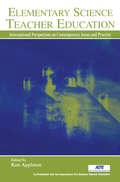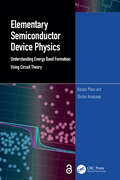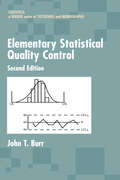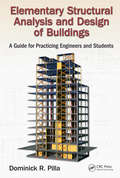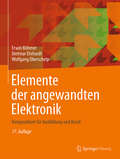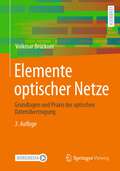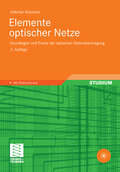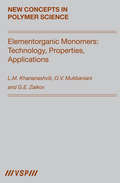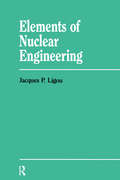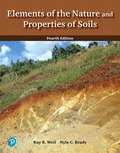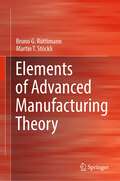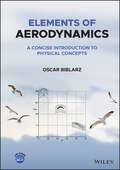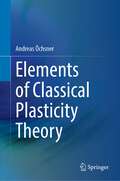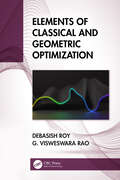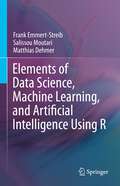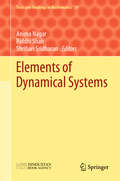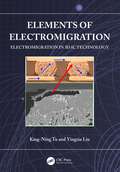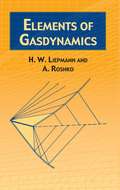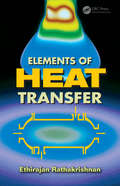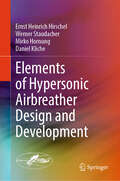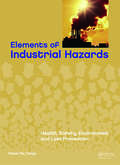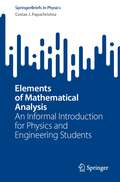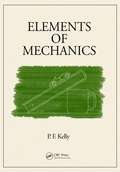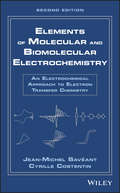- Table View
- List View
Elementary Science Teacher Education: International Perspectives on Contemporary Issues and Practice
by Ken AppletonCo-Published with the Association For Science Teacher Education. Reflecting recent policy and standards initiatives, emerging research agendas, and key innovations, this volume provides a contemporary overview of important developments and issues that have that have in recent years shaped elementary science education pre-service courses and professional development, and practices that are shaping future directions in the field. Contributors from several countries who are actively engaged in research and design in elementary science education address:*Conceptual issues which impinge on contemporary science teacher education;*Intersections of content, pedagogy, and practice; and*Professional development as a contextualized practice.Elementary Science Teacher Education: International Perspectives on Contemporary Issues and Practice offers a clear picture of the current state of the field and directions for the future--to the benefit of elementary science teacher educators, aspiring teacher educators, school policy makers, other professionals involved in science education and, ultimately, the millions of elementary school children who will gain from improved practice.
Elementary Semiconductor Device Physics: Understanding Energy Band Formation Using Circuit Theory
by Kazuya Masu Shuhei AmakawaThis book by two leading experts on integrated circuit design adopts an untraditional approach to introducing semiconductor devices to beginners. The authors use circuit theory to provide a digestible explanation of energy band theory and understanding of energy band diagrams. After briefly summarizing the basics of semiconductors, the authors describe semiconductor devices from a circuit theoretic point of view, making the book especially suitable for circuit design students and engineers. Further to the emphasis on the circuit perspective, the book then uses circuit theory to introduce readers to the famously indigestible “energy bands” of crystalline solids. Additionally, the book explains how to read physics from “energy band diagrams” of semiconductor devices in great detail. The key to appreciating the real power of energy band diagrams is shown to lie in the understanding of the concept of the “quasi-Fermi levels,” introduced in 1949 by William Shockley but remaining elusive to date and therefore often omitted from energy band diagrams. To rectify this, some of the energy band diagrams presented in this book, complete with quasi-Fermi levels, were drawn using a device simulator (a.k.a. technology computer-aided design; TCAD), offering quantitative information about device physics. The book could, therefore, also serve as a hands-on course text in TCAD-drawn band diagram reading.Because no prior exposure to quantum mechanics is required and the book does not attempt to teach it, this book is ideal for students in various disciplines who may or may not be specializing in semiconductor devices. The numerous practical examples of reading TCAD-based energy-band diagrams are also invaluable to practicing semiconductor device engineers.
Elementary Statistical Quality Control (Statistics: A Series of Textbooks and Monographs)
by John T. BurrMaintaining the reader-friendly features of its popular predecessor, the Second Edition illustrates fundamental principles and practices in statistical quality control for improved quality, reliability, and productivity in the management of production processes and industrial and business operations. Presenting key concepts of statistical quality c
Elementary Structural Analysis and Design of Buildings: A Guide for Practicing Engineers and Students
by Dominick R. PillaThis overview of the analysis and design of buildings runs from basic principles and elementary structural analysis to the selection of structural systems and materials, and on to foundations and retaining structures. It presents a variety of approaches and methodologies while featuring realistic design examples. <P><P> As a comprehensive guide and desk reference for practicing structural and civil engineers, and for engineering students, it draws on the author’s teaching experience at The City College of New York and his work as a design engineer and architect. It is especially useful for those taking the National Council of Examiners for Engineering and Surveying SE exam.
Elemente der angewandten Elektronik: Kompendium Für Ausbildung Und Beruf (Viewegs Fachbücher Der Technik Ser.)
by Erwin Böhmer Dietmar Ehrhardt Wolfgang OberschelpDas zu Grunde liegende erfolgreiche didaktische Konzept wird beibehalten. Mit seinem besonderen Aufbau, der Behandlung von Themen auf jeweils einer Text- und einer Bildseite, ist das Buch durchgängig und übersichtlich gestaltet. Die einzelnen Gebiete sind in sich geschlossen behandelt und lassen sich für unterschiedliche Lehrveranstaltungen sowie autodidaktisch verwenden. Mit seinen zahlreichen Beispielen vermittelt das Buch zwischen Theorie und Praxis. Es ist ein zuverlässiger Begleiter für das Elektronikpraktikum und darüber hinaus Arbeitsgrundlage für Schaltungsentwickler. Diese 17. Auflage ...
Elemente optischer Netze: Grundlagen und Praxis der optischen Datenübertragung
by Volkmar BrücknerIn diesem einführenden und kompakten Lehrbuch werden die wichtigsten Elemente von optischen Netzen eingeführt und für die ingenieurmäßige Lösung praktischer Probleme aufbereitet. Thematische Schwerpunkte sind Glas- und Polymerfasern, optische Sender und Empfänger, die Modulation von Laserlicht für hochbitratige Übertragungen, Elemente passiver (Koppler, Verzweiger) und aktiver (Schalter, optische Verstärker) Netze und der Einfluss nichtlinearer Effekte auf die optische Datenübertragung. An Beispielen werden Vorteile und Grenzen der Datenübertragung in optischen Netzen erläutert. Zu jedem Schwerpunkt werden praxisnahe bzw. praxisorientierte Fragen und Aufgaben gestellt. Schwierige mathematische Zusammenhänge und Formeln werden nachvollziehbar in MathCad® simuliert.
Elemente optischer Netze: Grundlagen und Praxis der optischen Datenübertragung
by Volkmar BrücknerIn diesem einführenden und kompakten Lehrbuch werden die wichtigsten Elemente von optischen Netzen eingeführt und für die ingenieurmäßige Lösung praktischer Probleme aufbereitet. Thematische Schwerpunkte sind Glas- und Polymerfasern, optische Sender und Empfänger, die Modulation von Laserlicht für hochbitratige Übertragungen, Elemente passiver (Koppler, Verzweiger) und aktiver (Schalter, optische Verstärker) Netze und der Einfluss nichtlinearer Effekte auf die optische Datenübertragung. An Beispielen werden Vorteile und Grenzen der Datenübertragung in optischen Netzen erläutert. Zu jedem Schwerpunkt werden praxisnahe bzw. praxisorientierte Fragen und Aufgaben gestellt. Schwierige mathematische Zusammenhänge und Formeln werden nachvollziehbar in MathCad® simuliert.
Elementorganic Monomers: Technology, Properties, Applications
by Gennady E. Zaikov L.M. Khananashvili O.V. MukbanianiNew fields of science and technology call for new materials with valuable performance characteristics. Long-term resistance to such temperatures can be found only in polymers with chains made up of thermostable fragments. Particularly interesting in this respect are elementorganic polymers with inorganic and organo-inorganic molecular chains. Elementorganic polymers are not only highly thermostable, but also perform well under low temperatures, sunlight, humidity, weather, etc. Thus, these polymers (especially silicones) are widely and effectively used in the electrical, radio, coal, mechanical rubber, aircraft, metallurgical, textile, and other industries. They are of great utility not only in industry, but also in households and in medicine, where their merits can hardly be overestimated.The need to publish this book arose with the scientific and technical developments of the last decade, the reconstruction and technical renovation of existing factories, as well as fundamental changes in some syntheses of elementorganic monomers and polymers. Moreover, nowadays it is essential to train highly skilled chemical engineers with a comprehensive knowledge of current chemistry, of the production technology of elementorganic monomers and polymers, and of their characteristics and applications.
Elements Nuclear Engineering
by Sara Mitter Jacques P. LigouFirst Published in 1986. This work should be considered as a simple introduction to nuclear engineering. It covers and somewhat enlarges upon a set of courses that the author’s currently give at the Ecole Polytechnique Federale of Lausanne, Switzerland.
Elements Of The Nature And Properties Of Soils
by Raymond Weil Nyle BradyAt the forefront of soil science for over a century, Elements of the Nature and Properties of Soils considers the role of soils as both a natural resource and an ecosystem, while highlighting interactions between soils and other components of natural and constructed ecosystems. With practical value for meeting today’s environmental challenges, the text asserts that balancing economic growth with sustainable economies requires a deep understanding of soils. The 4th edition has been abridged to focus on fundamentals, while providing new or updated discussions on topics such as soils and human health, organic farming, and soil food-web ecology.
Elements of Advanced Manufacturing Theory
by Bruno G. Rüttimann Martin T. StöckliThis book is the continuation of the textbook Lean Compendium – Introduction to Modern Manufacturing Theory. It extends the theory of mathematical modeling to batch & queue-based cyber-physical production systems. To facilitate learning, the book continues to develop a Cartesian-derived understanding of the system’s behavior by applying manufacturing-specific theorems, corollaries and lemmas. A law-based description enables to model production mathematically and understand upfront their dynamics in terms of WIP generation, lead-times, exit-rates, and on-time delivery performance. While simulation alone only allows to explore the optimum solution, the development of a theory allows to gain knowledge. This improves the learning of the “physics” of manufacturing systems and contributes to a solid production’s understanding and a clear and cognitive problem determination that leads to a thorough mental capture for mastering a systematic design of such highly complex systems.
Elements of Aerodynamics: A Concise Introduction to Physical Concepts
by Oscar BiblarzELEMENTS OF AERODYNAMICS An accessible and hands-on textbook filled with chapter objectives, examples, practice problems, sample tests, and an online aero-calculator In Elements of Aerodynamics, Professor Oscar Biblarz delivers a concise and fundamentals-oriented approach to aerodynamics suitable for both undergraduate and graduate-level students. The text offers numerous problems, examples, and check tests, allowing readers to gain and cement their knowledge through hands-on practice. Using a unique blend of fundamentals, the book provides students with a new approach to high lift airfoils including examples designed to complement the theory. It covers the most vital information on incompressible and compressible flow over two-dimensional and three-dimensional wings. A companion website that includes an interactive aero-calculator and additional student resources makes this a suitable text for online, hybrid, and distance learning. Readers will also find: A concise introduction to units and notation with discussion of the proper usage of dimensionless coefficients in aerodynamics, featuring descriptions of airflow as an incompressible and compressible low-viscosity medium past streamlined wings Comprehensive re-evaluation of the fundamentals of fluid dynamics, including the differential control volume approach and formulation of lift, drag, and pitching moments for thin, attached boundary layers over slender wings at high angles of attack Practical applications of mass, momentum, and energy relations, derived from Euler’s equation, Bernoulli’s equation, and the Kutta-Joukowski theorem Selected treatment of transonic and hypersonic aerodynamic aspects, including supercritical airfoils, the non-linear small perturbation potential equation, Newtonian theory, and hypersonic lift and drag Well-suited for students enrolled in an introductory aerodynamics course as part of an engineering program, Elements of Aerodynamics will also earn a place in the libraries of physics students and those interested in basic fluid mechanics.
Elements of Classical Plasticity Theory
by Andreas ÖchsnerThis monograph provides a compact introduction into the classical, i.e. rate-independent, plasticity theory. Starting from the engineering stress-strain diagram, the concept of elastic and elasto-plastic material behavior is introduced, as well as the concept of uniaxial and multiaxial stress states. Continuum mechanical modeling in the elasto-plastic range requires, in regards to the constitutive equation, in addition to the elastic law (e.g. Hooke’s law), a yield condition, a flow rule and a hardening rule. These basic equations are thoroughly introduced and explained for one-dimensional stress states. Considering three-dimensional plasticity, different sets of stress invariants to characterize the stress matrix and the decomposition of the stress matrix in its hydrostatic and deviatoric part are introduced. Furthermore, the concept of the yield condition, flow rule and hardening rule is generalized for multiaxial stress states. Some typical yield conditions are introduced and their graphical representation in different stress spaces is discussed in detail. The book concludes with an introduction in the elasto-plastic finite element simulation of mechanical structures. In the context of numerical approximation methods, the so-called predictor-corrector methods are used to integrate the constitutive equations. This is again introduced in detail based on one-dimensional stress states and afterwards generalized to the three-dimensional case. Test your knowledge with questions and answers about the book in the Springer Nature Flashcards app.
Elements of Classical and Geometric Optimization
by Debasish Roy G Visweswara RaoThis comprehensive textbook covers both classical and geometric aspects of optimization using methods, deterministic and stochastic, in a single volume and in a language accessible to non-mathematicians. It will help serve as an ideal study material for senior undergraduate and graduate students in the fields of civil, mechanical, aerospace, electrical, electronics, and communication engineering. The book includes: Derivative-based Methods of Optimization. Direct Search Methods of Optimization. Basics of Riemannian Differential Geometry. Geometric Methods of Optimization using Riemannian Langevin Dynamics. Stochastic Analysis on Manifolds and Geometric Optimization Methods. This textbook comprehensively treats both classical and geometric optimization methods, including deterministic and stochastic (Monte Carlo) schemes. It offers an extensive coverage of important topics including derivative-based methods, penalty function methods, method of gradient projection, evolutionary methods, geometric search using Riemannian Langevin dynamics and stochastic dynamics on manifolds. The textbook is accompanied by online resources including MATLAB codes which are uploaded on our website. The textbook is primarily written for senior undergraduate and graduate students in all applied science and engineering disciplines and can be used as a main or supplementary text for courses on classical and geometric optimization.
Elements of Data Science, Machine Learning, and Artificial Intelligence Using R
by Matthias Dehmer Frank Emmert-Streib Salissou MoutariThe textbook provides students with tools they need to analyze complex data using methods from data science, machine learning and artificial intelligence. The authors include both the presentation of methods along with applications using the programming language R, which is the gold standard for analyzing data. The authors cover all three main components of data science: computer science; mathematics and statistics; and domain knowledge. The book presents methods and implementations in R side-by-side, allowing the immediate practical application of the learning concepts. Furthermore, this teaches computational thinking in a natural way. The book includes exercises, case studies, Q&A and examples.
Elements of Dynamical Systems (Texts and Readings in Mathematics #79)
by Anima Nagar Riddhi Shah Shrihari SridharanThis book stems from lectures that were delivered at the three-week Advanced Instructional School on Ergodic Theory and Dynamical Systems held at the Indian Institute of Technology Delhi, from 4–23 December 2017, with the support of the National Centre for Mathematics, National Board for Higher Mathematics, Department of Atomic Energy, Government of India. The book discusses various aspects of dynamical systems. Each chapter of this book specializes in one aspect of dynamical systems and thus begins at an elementary level and goes on to cover fairly advanced material. The book helps researchers be familiar with and navigate through different parts of ergodic theory and dynamical systems.
Elements of Electromigration: Electromigration in 3D IC technology
by King-Ning Tu Yingxia LiuIn this invaluable resource for graduate students and practicing professionals, Tu and Liu provide a comprehensive account of electromigration and give a practical guide on how to manage its effects in microelectronic devices, especially newer devices that make use of 3D architectures. In the era of big data and artificial intelligence, next-generation microelectronic devices for consumers must be smaller, consume less power, cost less, and, most importantly, have higher functionality and reliability than ever before. However, with miniaturization, the average current density increases, and so does the probability of electromigration failure. This book covers all critical elements of electromigration, including basic theory, various failure modes induced by electromigration, methods to prevent failure, and equations for predicting mean-time-to-failure. Furthermore, effects such as stress, Joule heating, current crowding, and oxidation on electromigration are covered, and the new and modified mean-time-to-failure equations based on low entropy production are given. Readers will be able to apply this information to the design and application of microelectronic devices to minimize the risk of electromigration-induced failure in microelectronic devices. This book essential for anyone who wants to understand these critical elements and minimize their effects. It is particularly valuable for both graduate students of electrical engineering and materials science engineering and engineers working in the semiconductor and electronic packaging technology industries.
Elements of Friction Theory and Nanotribology
by Enrico Gnecco Ernst MeyerCombining the classical theories of contact mechanics and lubrication with the study of friction on the nanometer range, this multi-scale book for researchers and students alike guides the reader deftly through the mechanisms governing friction processes, based on state-of-the-art models and experimental results. The first book in the field to incorporate recent research on nanotribology with classical theories of contact mechanics, this unique text explores atomic scale scratches, non-contact friction and fishing of molecular nanowires as observed in the lab. Beginning with simple key concepts, the reader is guided through progressively more complex topics, such as contact of self-affine surfaces and nanomanipulation, in a consistent style, encompassing both macroscopic and atomistic descriptions of friction, and using unified notations to enable use by physicists and engineers across the scientific community.
Elements of Gas Dynamics (Dover Books on Aeronautical Engineering)
by A. Roshko H. W. LiepmannThe increasing importance of concepts from compressible fluid flow theory for aeronautical applications makes the republication of this first-rate text particularly timely. Intended mainly for aeronautics students, the text will also be helpful to practicing engineers and scientists who work on problems involving the aerodynamics of compressible fluids. Covering the general principles of gas dynamics to provide a working understanding of the essentials of gas flow, the contents of this book form the foundation for a study of the specialized literature and should give the necessary background for reading original papers on the subject. Topics include introductory concepts from thermodynamics, including entropy, reciprocity relations, equilibrium conditions, the law of mass action and condensation; one-dimensional gasdynamics, one-dimensional wave motion, waves in supersonic flow, flow in ducts and wind tunnels, methods of measurement, the equations of frictionless flow, small-perturbation theory, transonic flow, effects of viscosity and conductivity, and much more. The text includes numerous detailed figures and several useful tables, while concluding exercises demonstrate the application of the material in the text and outline additional subjects. Advanced undergraduate or graduate physics and engineering students with at least a working knowledge of calculus and basic physics will profit immensely from studying this outstanding volume.
Elements of Heat Transfer
by Ethirajan RathakrishnanWritten for chemical, mechanical, and aerospace engineering students taking courses on heat and mass transfer, this textbook presents the basics and proceeds to the required theory and its application aspects. Major topics covered include conduction, convection, radiation, boiling, heat exchangers, and mass transfer and are explained in a detailed,
Elements of Hypersonic Airbreather Design and Development
by Ernst Heinrich Hirschel Werner Staudacher Mirko Hornung Daniel KlicheThis book sketches key design, development, and engineering issues. To think up an airbreathing hypersonic aircraft is one thing; to design, develop, and produce it is another one. Airframe-propulsion integration plays a central role, with six integration types identified. Most demanding is that of a large aircraft with both lift and propulsion located at its lower side—an approach exemplified early by the US National Aerospace Plane. Topics treated are the flight environment, design sensitivities, fuel considerations, aerothermodynamics, scramjet propulsion, airframe-propulsion integration, structural and materials issues, and aerothermoelasticity. Persistent challenges include laminar-turbulent transition and joint modelling. Capabilities and shortcomings of experimental, computational, and in-flight simulation are considered. The second wave of mathematization—culminating in the concept of the virtual product—has fundamentally transformed flight vehicle design, enabling integrated, high-fidelity simulation across disciplines. In this book, students, design engineers, and technical managers will find ample insight and practical knowledge regarding hypersonic airbreather design.
Elements of Industrial Hazards: Health, Safety, Environment and Loss Prevention
by Ratan Raj TatiyaAn introductory course on Health, Safety and Environment (HSE) as applicable to all manufacturing and exploration engineering industries. Its first part deals with fundamentals, ecology and environmental engineering and covers air and water pollution sources, magnitude, measuring techniques and remedial measures to minimize them. The second pa
Elements of Mathematical Analysis: An Informal Introduction for Physics and Engineering Students (SpringerBriefs in Physics)
by Costas J. PapachristouThis book provides a comprehensive yet informal introduction to differentiating and integrating real functions with one variable. It also covers basic first-order differential equations and introduces higher-dimensional differentiation and integration. The focus is on significant theoretical proofs, accompanied by illustrative examples for clarity. A comprehensive bibliography aids deeper understanding. The concept of a function's differential is a central theme, relating to the "differential" within integrals. The discussion of indefinite integrals (collections of antiderivatives) precedes definite integrals, naturally connecting the two. The Appendix offers essential math formulas, exercise properties, and an in-depth exploration of continuity and differentiability. Select exercise solutions are provided. This book suits short introductory math courses for novice physics/engineering students. It equips them with vital differential and integral calculus tools for real-world applications. It is also useful for first-year undergraduates, reinforcing advanced calculus foundations for better Physics comprehension.
Elements of Mechanics
by P.F. KellyThe first volume in a three-part series, Elements of Mechanics provides a rigorous calculus-based introduction to classical physics. It considers diverse phenomena in a systematic manner and emphasises the development of consistent and coherent models guided by symmetry considerations and the application of general principles. Modern developments c
Elements of Molecular and Biomolecular Electrochemistry: An Electrochemical Approach to Electron Transfer Chemistry (Baker Lecture Ser. #13)
by Jean-Michel Savéant Cyrille CostentinWritten by two of the world's leading authorities in the field of electrochemistry, this book comprehensively addresses workhorse electrochemical reactions that serve as the basis of modern research for alternative energy solutions. Provides an accessible and readable summary on the use of electrochemical techniques and the applications of electrochemical concepts to functional molecular-level systems Includes a new chapter on proton coupled electron transfer, a completely revamped chapter on molecular catalysis of electrochemical reactions, and added sections throughout the book Bridges a gap and strengthens the relationship between electrochemists, molecular and biomolecular chemists—showing a variety of functions that may be obtained by multi-component systems designed using the paradigms of both chemistries
